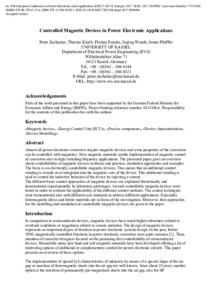| dc.date.accessioned | 2021-09-14T15:33:52Z | |
| dc.date.available | 2021-09-14T15:33:52Z | |
| dc.date.issued | 2017 | |
| dc.identifier | doi:10.17170/kobra-202109074723 | |
| dc.identifier.uri | http://hdl.handle.net/123456789/13242 | |
| dc.description | Proceedings der Konferenz 19th European Conference on Power Electronics and Applications (EPE'17 ECCE Europe) vom 11-14 Sept. 2017 in Warschau, Polen. | ger |
| dc.description.sponsorship | Parts of the work presented in this paper have been supported by the German Federal Ministry for Economic Affairs and Energy (BMWi). Project funding reference number: 0324106A. | eng |
| dc.language.iso | eng | eng |
| dc.publisher | IEEE | |
| dc.rights | Urheberrechtlich geschützt | |
| dc.rights.uri | https://rightsstatements.org/page/InC/1.0/ | |
| dc.subject | magnetic device | eng |
| dc.subject | Eenergy Control Unit (ECU) | eng |
| dc.subject | passive component | eng |
| dc.subject | device characterisation | eng |
| dc.subject | device modelling | eng |
| dc.subject.ddc | 620 | |
| dc.title | Controlled magnetic devices in power electronic applications | eng |
| dc.type | Konferenzveröffentlichung | |
| dcterms.abstract | Almost all power electronic converters require magnetic devices and some properties of the converters can be controlled with magnetics. New magnetic materials enable implementation of magnetic control of converters also in high switching frequency applications. The presented paper gives an overview about controllability of magnetic devices in theory and practice, simulation approaches and examples. The focus is on electrically controllable magnetic devices. This means that an additional control winding is wound on or integrated into the magnetic core of the device. This additional winding is used to control the inductive behavior of the device by injecting a current. The different basic control approaches of magnetic devices are explained theoretically and demonstrated experimentally by laboratory prototypes. Several controllable magnetic devices were tested in order to evaluate the applicability of the different control methods. The control techniques were demonstrated also with different core materials to address different applications. Especially ferromagnetic alloys and ferrite materials are in focus of the investigation. Moreover, first approaches for the modelling and simulation of controllable magnetic devices are given in the paper. | eng |
| dcterms.accessRights | open access | |
| dcterms.creator | Zacharias, Peter | |
| dcterms.creator | Kleeb, Thiemo | |
| dcterms.creator | Fenske, Florian | |
| dcterms.creator | Wende, Jiajing | |
| dcterms.creator | Pfeiffer, Jonas | |
| dc.publisher.place | Piscataway, New Jersey | |
| dc.relation.doi | doi:10.23919/EPE17ECCEEurope.2017.8099004 | |
| dc.relation.projectid | BMWi: 0324106A | |
| dc.subject.swd | Elektromagnet | ger |
| dc.subject.swd | Konverter <Elektronik> | ger |
| dc.subject.swd | Werkstoffforschung | ger |
| dc.subject.swd | Steuergerät | ger |
| dc.type.version | acceptedVersion | |
| dcterms.source.collection | 19th European Conference on Power Electronics and Applications (EPE'17 ECCE Europe) [Proceedings] | eng |
| dcterms.source.identifier | eisbn:978-90-75815-27-6 | |
| dcterms.source.identifier | isbn:978-1-5386-0530-1 | |
| dcterms.source.pageinfo | P.1-P.10 | |
| kup.iskup | false | |
| dcterms.source.articlenumber | 17353369 | |

